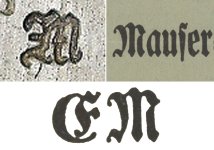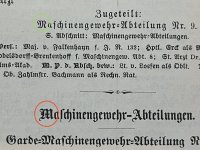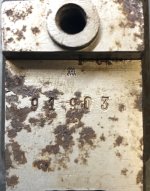You are using an out of date browser. It may not display this or other websites correctly.
You should upgrade or use an alternative browser.
You should upgrade or use an alternative browser.
S28 to Karab98b Evolution - new insights
- Thread starter bruce98k
- Start date
Absolut
Senior Member
Bruce, indeed interesting. Does the total of 15.000 rifles from this contract correspond to the serials of S28 rifles?
The text
"fob. Versch.Hafen
seem. verpackt,
10% f. Broumis,
5% f. Bergmann, Berlin"
most possibly means
"free on board Verschiffung Hafen
seemäßig verpackt,
10% (Provision) für Broumis,
5% (Provision) für Bergmann, Berlin"
or translated
"free on board shipment harbour
seaworth packing,
10% (provision) for Broumis,
5% (provision) for Bergmann, Berlin"
Jon, that document is from Mauser, right? Wasn't the earlier believe that S28 rifles come from Simson?
The text
"fob. Versch.Hafen
seem. verpackt,
10% f. Broumis,
5% f. Bergmann, Berlin"
most possibly means
"free on board Verschiffung Hafen
seemäßig verpackt,
10% (Provision) für Broumis,
5% (Provision) für Bergmann, Berlin"
or translated
"free on board shipment harbour
seaworth packing,
10% (provision) for Broumis,
5% (provision) for Bergmann, Berlin"
Jon, that document is from Mauser, right? Wasn't the earlier believe that S28 rifles come from Simson?
Since this is clearly a commercial transaction, I would consider the very strong possibility that these are Mod. 1924 rifles (Standard-Modell) incorrectly recorded as "1928". Wouldn't be the first time something like that happened on paperwork.
IMO, I seriously doubt these are S/28 rifles.
IMO, I seriously doubt these are S/28 rifles.
Makes sense as Greece (Yugo's as well) was a cover for arms shipments during the Spanish Civil War, - not directly related but part of a pattern.I have not seen the reference to "Mod.1928" before so that's completely new.
The exporter is located in Athens but I wonder if that was a cover to keep this delivery under the radar so to speak.
Again, another data point in this puzzle.
Stephan98k
aka 8x57IS
I have attached two images of parts from an early 1933 Banner K rifle manufactured at Mauser Oberndorf.
One is a sight ramp and the other is an underside view of the bolt sleeve. The tell on these images is the small
Gothic 'm' stamped on the parts, indicating that the part was manufactured at Oberndorf. Jon Speed has been
aware of this mark for some time but it had no major implications other than the fact that it localized the component
to the main Mauser factory.
With the whole story of the S28 (BKIW) rifles being incomplete, we know can begin filling in some of the blanks.
If you look at some of the images from some of the S28 rifles posted, you can clearly see this small 'M' marked on the
rear sight base and just behind the recoil lug of the receiver.
Ok, now for the questions.
1. How was the manufacture of components distributed by the following companies: surplus DWM components (early), Mauser, BKIW, and last the Simson company.
2. We can assume that the point of assembly was in Karlsruhe at the BKIW facility but was it strictly an assembly point, or were components manufactured there as well
3. Where did the stocks come from?
4. How much was Mauser Oberndorf involved (knowing that major components were being transferred from Mauser to BKIW)?
5. Why are there Simson inspection stamps (E/6) on rear sight bases supplied by Oberndorf.
Look forward to further discussion on this topic.
I checked my WWI and earlier WMOs, they mostly have Ys and Bs on the receiver, triggerguard, and recoil lug. But i have seen the M on armorers parts sent to the Ottomans, and on the triggerguard of my 1917 marked but likely postwar assembled commercial WMO.
1714b has an e/6 hardening acceptance but also a WMO M, so it makes me wonder about the relationship between the two. If Simson took unfinished parts from WMO, did they finish them before sending them to Karlsruhe? Would be similar to their relationship with Dresden at the end of WWI.
That would be my assumption on the rear sight bases.
Mauser made the base and for some reason, it was sent to Simson for final inspection.
My guess it was part of the covert activity going on with the production of the S28 rifles.
The direction flipped when Mauser began production of the Banner K series of rifles.
In the early phases of production Mauser used numbers of front and rear bands, bolt bodies and bolt shrouds.
All were marked 'S28'. DWM must have transferred all the surplus components back to Mauser.
The whole situation regarding Mauser and DWM is fairly chaotic in the 1924 to 1933 period.
Jon Speed did check the Mauser financial records and there is activity between Karlsruhe and the factory in Oberndorf.
More to follow.
There are many things that need to be discussed in the next time, I will start with this little marking. At first glance it looks like a Gothic "M", please take a closer look at it.

Here is a enlarged section of Bruce's early Mauser Banner K rifle on the left side. On the right side I placed the word "Mauser" and below of it the letters "M" and "E".
It looks like an company logo, a letter "M"combined with the mirrored letter "E".
5.) The last question should rather be "Was it really Mauser Oberndorf who supplied these parts? By the way, the inspector with the (E/6) was responsible in Suhl and Erfurt area.
Cyrano4747
Well-known member
View attachment 440113
Here is a enlarged section of Bruce's early Mauser Banner K rifle on the left side. On the right side I placed the word "Mauser" and below of it the letters "M" and "E".
It looks like an company logo, a letter "M"combined with the mirrored letter "E".
I wouldn't lean too hard on it being a combo of an M and a mirrored E. There was no single Fraktur typeface, and a lot of the different variants had a little flourish off the left side of the M like in the stamp.
Here is a quick and dirty example from a book I have on my desk right now (the 1910 Rangliste). Look at the capital M in "maschinengewehr" circled up top in green, and compare it to the (bold) capital M in the same word below, circled in red.

And that's the same word in the same document using what is likely the same typeface family, just one is the bold/title version. There are other differences too if you dig in, the use of a - for a hyphen rather than a = as well. The medial s ( ſ ) in "Maschinengewehr" visibly differs, for example, and we have two different versions of capital-A (closed and open).
German typography before the 1930s is just a mess.
My two cents are that the letter in question is just a capital M, not a combination of multiple letters.
Last edited:
Cyrano4747
Well-known member
Which begs the question that if it was a secretive program they might have tried to obfuscate it, but if you're hiding the origin why would you go with a non-standard font but still use M for Mauser?
Again, that is pretty raw conjecture.
Never mind, I stand corrected.
Last edited:
Cyrano4747
Well-known member
You're right, I stand corrected.
I stand by that being a capital "M" in a slightly fancier font and not a logo made from combining multiple letters into one.
I stand by that being a capital "M" in a slightly fancier font and not a logo made from combining multiple letters into one.
Fal Grunt
Senior Member
Bruce,
Is this the m you are referring to?
I think the sub-contractor field is something that will take extensive documentation and research to further identify and nail down.
Jon may be the only one that can speak to this from documentation, but what examples do we have of known suppliers supplying a certain part that we can then correlate to a part marking? Pre K98k examples that is.
To use the commonly seen "S" marked parts that are associated with Mauser. They are commonly found on Mauser rifles, but are found on other contracts/countries rifles as well. Most notably, large quantities of Mexican 1910 rifles have S marked triggers and safeties, identical to those found on Mauser produced rifles. Recent research has shown that Mexico never achieved domestic production for the 1910 (in production through 1934 if memory serves) and purchased large quantities of parts, which it then assembled into rifles.
Were these S marked triggers and safeties contracted from Mauser by the Mexican government in the 20's and 30's? Were they left over components from Pre WWI that were obtained through ??? channels by Mexico?
Fun fact, S marked triggers and safeties appear on Mauser rifles dating back to 1891!
I spend a lot of time looking at parts, and Mauser made parts have a dizzying amount of variety in parts markings. Even in the same model/component. In addition to S there are H, F, K, C, L, M, T, G, J, and then there are the Fraktur fonts and then the stylized fonts and then the "I don't know what's". (Like the stamp that looks similar to the Pillars of Gediminas on parts that were made by Mauser but clearly were not for Lithuania) Possibly Mauser reusing old stamps (which they must have had thousands of) from previous contracts for different work groups/masters/cells.
I've recently been tracking a fraktur U which shows on Mauser parts from early 1900's to the Standard Modells.
And if the marks are subcontractors, which they might be, then a PROLIFIC number of parts would have been provided by subcontractors. The fraktur S, Crazy S, canted S, and others that are often associated with Sauer, would mean, Sauer provided TONS of parts to Mauser, including receivers for several large contracts, commercial rifles, etc.
When I maintained dies for a Allison part, the parts were not marked A for Allison, why would Allison want their own parts marked? Nor were they marked for the company I worked for. When I was running them they had a K stamp, which the part was on Revision K, and a nonsensical date code system. Some of the letters could be design revisions. They could be date codes for production. Or as mentioned before work groups/masters/cells.
The common opinion that they are simply inspection/process markings may have some merit. I am working on 100 some pages of inspection for the Gewehr 98, but I have yet to see on any of the process steps mark, stamp, etc. Nor do any of the gauges seem to correlate.
Just food for thought
Is this the m you are referring to?
I think the sub-contractor field is something that will take extensive documentation and research to further identify and nail down.
Jon may be the only one that can speak to this from documentation, but what examples do we have of known suppliers supplying a certain part that we can then correlate to a part marking? Pre K98k examples that is.
To use the commonly seen "S" marked parts that are associated with Mauser. They are commonly found on Mauser rifles, but are found on other contracts/countries rifles as well. Most notably, large quantities of Mexican 1910 rifles have S marked triggers and safeties, identical to those found on Mauser produced rifles. Recent research has shown that Mexico never achieved domestic production for the 1910 (in production through 1934 if memory serves) and purchased large quantities of parts, which it then assembled into rifles.
Were these S marked triggers and safeties contracted from Mauser by the Mexican government in the 20's and 30's? Were they left over components from Pre WWI that were obtained through ??? channels by Mexico?
Fun fact, S marked triggers and safeties appear on Mauser rifles dating back to 1891!
I spend a lot of time looking at parts, and Mauser made parts have a dizzying amount of variety in parts markings. Even in the same model/component. In addition to S there are H, F, K, C, L, M, T, G, J, and then there are the Fraktur fonts and then the stylized fonts and then the "I don't know what's". (Like the stamp that looks similar to the Pillars of Gediminas on parts that were made by Mauser but clearly were not for Lithuania) Possibly Mauser reusing old stamps (which they must have had thousands of) from previous contracts for different work groups/masters/cells.
I've recently been tracking a fraktur U which shows on Mauser parts from early 1900's to the Standard Modells.
And if the marks are subcontractors, which they might be, then a PROLIFIC number of parts would have been provided by subcontractors. The fraktur S, Crazy S, canted S, and others that are often associated with Sauer, would mean, Sauer provided TONS of parts to Mauser, including receivers for several large contracts, commercial rifles, etc.
When I maintained dies for a Allison part, the parts were not marked A for Allison, why would Allison want their own parts marked? Nor were they marked for the company I worked for. When I was running them they had a K stamp, which the part was on Revision K, and a nonsensical date code system. Some of the letters could be design revisions. They could be date codes for production. Or as mentioned before work groups/masters/cells.
The common opinion that they are simply inspection/process markings may have some merit. I am working on 100 some pages of inspection for the Gewehr 98, but I have yet to see on any of the process steps mark, stamp, etc. Nor do any of the gauges seem to correlate.
Just food for thought
Attachments
Last edited:
The 'm' is a known in-house Mauser inspection stamp used in the pre-1935 period.
There are a few other Gothic font inspection stamps found on Banner K and early Standard-Modells.
It does represent the Mauser firm but does not denote M= Mauser for clarification.
There are a few other Gothic font inspection stamps found on Banner K and early Standard-Modells.
It does represent the Mauser firm but does not denote M= Mauser for clarification.


